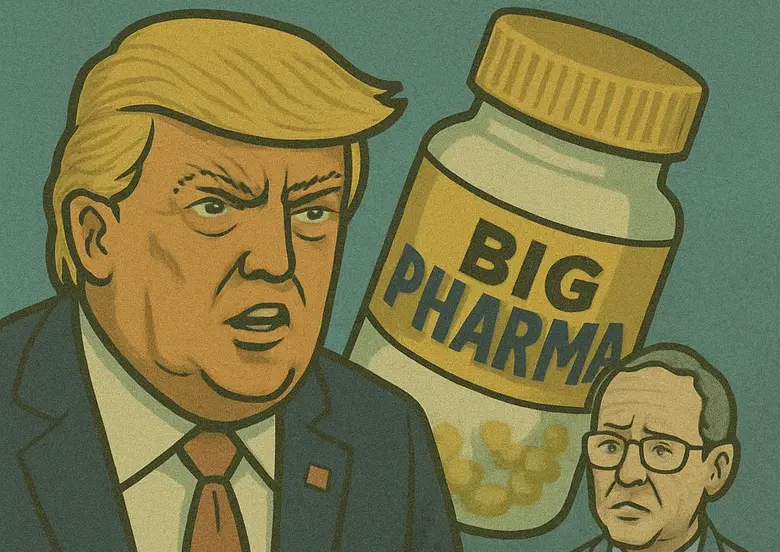Donald Trump’s bold promise to reignite American manufacturing through tariffs has hit a wall. Factories once expected to thrive are now cutting jobs, while allies mirror Washington’s protectionist tactics. From drug plants in North Carolina to steel mills in Britain, the ripple effects are shaking entire sectors. What began as a plan to bring jobs home is now backfiring on multiple fronts.
The Pharmaceutical Fallout: Jobs Vanishing Instead of Growing
When Donald Trump returned to the White House, he reignited his pledge to rebuild America’s industrial power. Factories in Michigan, Pennsylvania, and North Carolina were to roar back to life, fueled by tariffs designed to force companies to build plants here and hire American workers. The plan expanded beyond steel and aluminum to target Big Pharma, with proposed 100% tariffs on imported branded drugs unless firms built in the U.S.
The goal sounded simple: protect jobs and secure domestic production. But the outcome told a different story. In Clayton, North Carolina, Novo Nordisk, the maker of Wegovy and Ozempic, began cutting dozens of positions in production, quality control, and HR. The very jobs tariffs aimed to protect were now vanishing.
Why? Manufacturing investments take years. Global supply chains are deeply rooted, and rising costs often outweigh tariff incentives. Tariffs may shield borders, but they can’t force expansion. Instead of creating a manufacturing boom, Trump’s policy revealed its first misfire, where economic mechanics clashed with political ambition.
The Enforcement Problem: Unclear Rules and Murky Timelines
A key pillar of Trump’s tariff agenda was to repatriate drug manufacturing, imposing up to 100% tariffs on imported branded medicines unless companies produced in the U.S. The goal was to make America the center of pharmaceutical finishing, packaging, and assembly. But under the surface, problems emerged.
The policy’s enforcement was unclear. Terms like “building plants” lacked definition, and timelines were murky. Reports revealed the plan was effectively on hold as regulators and pharma giants debated logistics. While companies like Eli Lilly pledged major domestic investments, including a $5 billion advanced therapy plant in Virginia, such projects take years and rely on highly skilled labor rather than mass hiring.
Meanwhile, Novo Nordisk’s global restructuring cut 9,000 roles, including U.S. jobs, undermining the tariffs’ intent across the pharma value chain from APIs to packaging. Companies faced rising costs, production delays, and strategic uncertainty. The effort to force reshoring exposed a deeper flaw: tariffs can inspire ambition, but they don’t guarantee growth, only new strains on already complex supply chains.
Europe’s Counterstrike: The Tariff War Comes Full Circle
As the U.S. doubled down on protectionism, Europe followed suit. The European Commission recently proposed doubling steel import tariffs to 50% for shipments exceeding reduced quotas, cutting allowable imports to 18.3 million tonnes, nearly half the previous limit. The message from Brussels is unmistakable: if America fortifies its markets, Europe will too.
This marks a sharp shift for a bloc that once championed open trade and WTO rules. Now it’s prioritizing domestic jobs and industry survival over global free trade ideals. The consequences ripple across continents. Exporters face higher barriers while manufacturers brace for rising steel costs and shrinking profit margins for automakers and heavy industry players.
Steel, the backbone of production, has become a pressure point. Higher costs mean reconfigured supplier networks, relocated factories, and potential job losses. But Europe isn’t the only one tightening its grip across the channel. Britain’s once mighty steel industry is now under siege, and the stakes are even higher.
Britain’s Meltdown: The Steel Industry Crushed by Colliding Tariffs
Nowhere is the fallout from tariff wars more severe than in the UK. Once a cornerstone of global steelmaking, Britain’s industry is now buckling under pressure. Under the EU’s new steel plan, nearly 80% of British exports to Europe face tighter quotas, almost halved, and any excess shipments are hit with a 50% tariff.
Industry leaders warn this could be the biggest crisis the UK steel sector has ever faced. The government has already spent £235 million rescuing British Steel’s Scunthorpe plant. Yet the strain persists. Jobs are at risk, investments delayed, and supply chains rerouted amid fierce competition from cheaper Chinese steel.
Unions caution that without decisive safeguards, steelmaking could vanish from the UK entirely. For automakers and suppliers, the consequences are immediate: rising costs, sourcing chaos, and production uncertainty. The very industries meant to thrive under protectionist policies are now battling higher prices, tighter supply chains, and fading investor confidence.
The Global Shockwave: How Tariffs Ripple Through Every Supply Chain
Here’s the crux: when protectionism spreads, the entire global engine starts to sputter. Steel, aluminum, tires, and components flow through international supply chains. So when tariffs rise, costs climb, production relocates, and jobs shift elsewhere, often not to the intended country.
In the U.S., the promised boom in pharma manufacturing never arrived. Novo Nordisk layoffs proved that point. In Britain, steel jobs are hanging by a thread. Across Europe, retaliatory tariffs mirror U.S. policies, fueling a worldwide trade spiral that fragments supply chains and kills investment for automakers.
This means higher steel and component costs, thinner margins, and reconsidered plant locations. Policy shocks are accelerating long-term change, especially amid China’s overcapacity, Europe’s energy costs, and shifting alliances. Tariffs were meant to restore industrial power, but instead they’re triggering layoffs, inflation, and uncertainty.
The Automotive Impact: Higher Costs and Production Uncertainty
For the automotive world, this verdict hits especially hard. Steel tariffs push up vehicle prices, suppliers face unpredictable sourcing, and assembly plants rethink their geography. The dream of bringing jobs home has collided with the reality of a hyperconnected global economy, one that can’t be walled off by tariffs without losing efficiency, innovation, and competitiveness.
In today’s interconnected auto ecosystem, building walls doesn’t rebuild jobs. It just moves them. The automotive industry faces higher steel and component costs, thinner margins, and production uncertainty as supply chains become increasingly fragmented and unpredictable.
The Final Verdict: Tariffs Misfire as the World Pays the Price
After tracing this journey from Trump’s grand promises of an industrial revival to the ripple effects hitting factories from North Carolina to Newcastle, one truth stands out: the tariff engine is misfiring. What began as a strategy to shield American industry has instead jammed the gears of global manufacturing.
Jobs haven’t surged; costs have. Allies aren’t yielding; they’re retaliating. The very industries meant to thrive—pharma, steel, autos—are now battling higher prices, tighter supply chains, and fading investor confidence. The dream of bringing jobs home has collided with the reality of a hyperconnected global economy.
Global Trade Reset: Adapt or Fall Behind
The tariff era proves one thing: protectionism can’t outpace interdependence. The winners of this new trade cycle will be the nations and companies that adapt — not retreat. From manufacturing to logistics, the next decade belongs to those who can navigate complexity with strategy and precision.
Explore Global Trade & Economic Policy Roles →The Broader Implications: A Global Trade Spiral
The consequences of this tariff war extend far beyond individual industries. When every nation fires up its own tariff engine, the entire global economy suffers. Supply chains that have been built over decades are being disrupted, investment is being delayed or canceled, and the very competitiveness that drives innovation is being undermined.
The pharmaceutical industry’s job cuts in North Carolina, the steel industry’s crisis in Britain, and the automotive sector’s production uncertainty all point to the same conclusion: protectionist policies designed to protect domestic industries are instead creating economic chaos and job losses across the globe.
FAQ Section
Q: Why are Trump’s tariffs backfiring on Big Pharma?
A: The tariffs were designed to force pharmaceutical companies to build plants in the U.S., but instead, companies like Novo Nordisk are cutting jobs. Manufacturing investments take years, and rising costs often outweigh tariff incentives, leading to job losses rather than job creation.
Q: How is Europe responding to U.S. tariffs?
A: Europe has proposed doubling steel import tariffs to 50% and cutting allowable imports nearly in half. This retaliatory approach mirrors U.S. protectionist tactics, creating a global trade spiral that fragments supply chains and increases costs for all industries.
Q: What’s happening to Britain’s steel industry?
A: Britain’s steel industry is facing its biggest crisis ever, with nearly 80% of exports to Europe facing tighter quotas and 50% tariffs on excess shipments. The government has already spent £235 million rescuing British Steel, but jobs remain at risk and the industry could vanish entirely.
Q: How do tariffs affect the automotive industry?
A: Tariffs increase steel and component costs, leading to higher vehicle prices, thinner margins, and production uncertainty. Suppliers face unpredictable sourcing, and assembly plants are reconsidering their locations, ultimately moving jobs rather than creating them.
The Bottom Line: A Failed Strategy with Global Consequences
Trump’s tariff strategy to bring manufacturing jobs back to America has backfired spectacularly. Instead of creating jobs, it’s cutting them. Instead of protecting industries, it’s destabilizing them. Instead of making America stronger, it’s creating economic chaos that affects every sector and every country.
The pharmaceutical industry’s job cuts, the steel industry’s crisis, and the automotive sector’s production uncertainty all demonstrate that protectionist policies don’t work in a hyperconnected global economy. The dream of bringing jobs home has collided with reality, and the world is paying the price.




